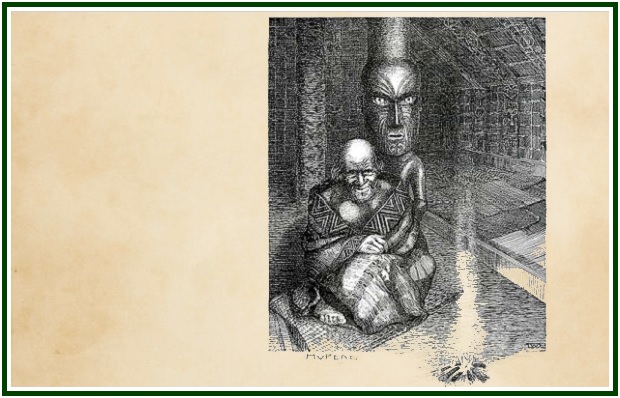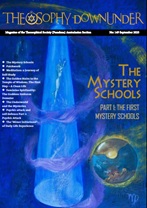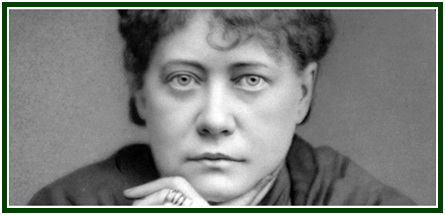
Universal Wisdom in the Myths of the
Maori, the Native Peoples of New Zealand
Andrew Rooke

A Tohunga, a wise man of the Maori people, near the carved image
of a god. Source: Te Ara, the Online Encyclopedia of New Zealand.
How marvelous is the diversity of man’s approach to universal and absolute ideas. Throughout the world peoples of all ages have sought to express man’s sacred heritage through the light of symbology designed to appeal to different ranges of cultural experience. One can often lose grasp of the golden thread of universality running through this vast panorama of myths, stories, and symbols if the still voice of intuition is allowed to be imprisoned in the molds of mind by unthinking loyalty to one’s own educational and cultural background and the lack of an attempt at empathy with our brothers of other nations.
It seems to me that the so-called primitive peoples of the world have been trying for a long time now to paint their own graphic portraits of man’s spiritual heritage, but we have often lost the opportunity to enhance our own understanding in the avalanche of our own prejudices and an overemphasis on the outer forms of what we have come to understand by “civilization”. There is no more poignant example of this than the myopic view taken by many Westerners in approaching the myths of the native peoples of New Zealand – the Maori. Their beautiful myths relating to the creation of the world and man have a wealth of color and depth to add to our feel for the spiritual roots of mankind, if we but have the eyes to see and the ears to hear the voice of the tohunga (wise men) reciting the age-old karakia or sacred myths.
It is said by the wise men that before the beginning there was a vast period of Nothingness, Te Kore. Then came the eternity of Te Po, when time was enshrouded in the great Night, the great Unknown. During this immense period of utter darkness, forces moved slowly and incomprehensibly to bring the universe into being. In some Maori traditions these universal forces are described as parts of a great tree, as they were by the Chaldeans, the Scandinavians, and the Hindus, who depict Brahma as the vast overspreading tree of the universe. In other versions they are given names suggestive of the different kingdoms of architects and builders of the manifest universe: Te Kune, the conceiving; Te Pupuke, the flowing forth; Te Hihiri, the persevering; Te Mahara, the power of thinking; Te Hinengaro, the mind; Te Manako, the desiring.
Encompassing and unfolding this great darkness was and is Io-matuakore, Io the Parentless – the Supreme Being who has existed for all time, who created no being yet was the origin of the universe and the kingdoms of lower gods. (Cf. Elsdon Best’s monograph, Some Aspects of Maori Myth and Religion, Dominion Museum, Wellington, New Zealand, pp. 23-26; also his monograph Spiritual and Mental Concepts of the Maori.) During the time when the Maori adhered to the old ways, even to speak his name was thought of as a sacrilege, so reverenced was the supreme symbol. The priesthood of Io consisted of a small number of initiated men highly trained in the esoteric lore and ritual, whose duties included the memorization and recitation of the ancient traditions of the Maori people.
Before the creation of even the lower gods, came the first glimmer of light struggling weakly through the blackness of Te Po. Gradually the heavens became light and Rangi nui, the Sky Parent, seeing the Earth Mother, Papa tu a nuku, far below him desired her. The primal parents were joined and their offspring were numerous (70 in some traditions), supernatural beings all male and all representative of the different forces active on the earth and the various expressions of sentient life thereon. Yet the creation was imperfect, for darkness shrouded the Earth Mother as Rangi the Sky Father still closely embraced her. Their sons clung to the side of Papa for an age, dreaming of the light and freedom denied them by the union of sky and earth.
From the first division of time unto the tenth, and to the hundredth, and to the thousandth, all was darkness. The black sky lay upon the earth and made her barren, and in vain did she seek her offspring in the likeness of the day, or of the night. – Antony Alpers, Maori Myths and Tribal Legends, p. 16
At length six of the supernatural beings spawned by Rangi and Papa grew weary of the darkness and argued heatedly amongst themselves whether to separate their parents by force “that man might arise”.
The fiercest of them, Tu-matauenga, the god of war (and also representative of the spirit of man), was the first to speak out suggesting that the brothers slay their parents. But Tane-mahuta, the god of the forests, growth, and fertilization, had another plan: “Nay, not so. It is better to rend them apart, and to let the heaven stand far above us, and the earth lie beneath our feet. Let the sky become as a stranger to us, but the earth remain close to us as a nursing mother”. (Sir George Grey, Polynesian Mythology and Ancient Traditional History of the New Zealand Race, p. 2) Five of the brothers agreed to this plan but Tawhiri-matea, god and father of the winds and storms, fearing that his kingdom would be overthrown, that the earth would become too beautiful and, jealous of his brother Tane as “author of the day”, alone dissented and was later to seek refuge in his father the Sky and wreak a fearful revenge on his brothers.
An age passed as the brothers formulated plans by which their parents might be separated and man called into existence. Then each of them rose in turn to assume the challenge of this awesome task. Even Tu, the god of war, with all his ferocious strength could not hack them apart. It became the turn of Tane, god and father of forests, who slowly applied himself with all his strength – the power of growth – and lo! Sky and Earth were separated and the multitude of beings crawling on the face of the Earth Mother, Papa, first saw light. Thus the old Maori saying: “It was the fierce thrusting of Tane which tore the heaven from the earth, so that they were rent apart, and darkness was made manifest, and so was the light” (Grey, p. 3). The power of growth had rent spirit and matter into the manifest duality, to bring light and freedom of expression to the offspring of the One, now moving freely on the breast of their nursing mother, Papa, the Earth.
Yet the creation was incomplete, for although Tu, the god of war, symbolizing the spirit of man, roamed free, there was no vehicle to give man form in this new world of life. Again the task fell to Tane, this time in his aspect of universal husband, to create woman and thus institute the condition called by the Maori ira tangata, human life, where before nothing had existed but ira atua, the supernatural condition of the gods. In a striking parallel to the Biblical story of creation, Tane fashioned woman from earth “red with the blood of the sinews” that once had fastened Rangi and Papa. Into this lifeless image of clay Tane breathed spirit and the power of thought obtained from Io the Supreme God and thus Hine-ahu-one, the Earth-formed Maid, the precursor of the ira tangata, came into being. From her union with Tane was born Hine-titama, the Dawn Maid, and thence all the races of man.
Many early Western observers looked upon this marvelous symbolism with embarrassment and repulsion or cited it as the confused ramblings of an isolated, primitive mentality. Latterly Freudian analysts have seen this powerful expression of universal truths in terms of the so-called Oedipal conflicts in man. Yet if one looks briefly at the myths of other races and makes an attempt to empathize with this form of stating man’s spiritual heritage, the grand universality of the ideas emerges. In one version of the Egyptian traditions of the creation, the deities Nut (the Sky) and Seb (the Earth) are forced apart by their son Shu-Heka, the god of the air. In the Sumerian epic the Sky Father An and the Earth Mother Ki are separated by their son Enlil, again representing the god of the air. Amongst the traditional peoples of Africa and North America similar legends are told by the wise men. The Zuni Indians of New Mexico tell us that in the far-distant past, compassionate beings seeking that the earth become fitter for life, lifted the Sky Father with their “strong cloud-bow” (Philip Freund, Myths of Creation, p. 59). Yet as the old Maori tohungas (wise men) patiently teach us in their beautiful symbols, Rangi the Sky, and Papa the Earth, still grieve for their lost love, rent apart that their offspring might stand upright in the light of self-conscious striving. Surely this yearning for conscious union of spirit and matter is reflected in the hearts of every son and daughter of Rangi and Papa.
The soft warm sighs of her [Earth’s] loving bosom still ever rise up to him, ascending from the woody mountains and valleys, and men call these mists; and the vast Heaven, as he mourns through the long nights his separation from his beloved, drops frequent tears upon her bosom, and men seeing these, term them dewdrops. – Grey, p. 9
000
The above article is available at the websites of the Independent Lodge of Theosophists since 31 August 2023. Copyright © 1976 by Theosophical University Press. The text was first published by Sunrise magazine, USA, in November 1976. Its publication by The Aquarian Theosophist and the websites of the ILT was authorized by the T.U.P. and the author in August 2023.

Andrew Rooke is the editor of the quarterly online magazine Theosophy Downunder, available at no cost or obligation by emailing: theosophydownunder@hotmail.com.
000
Read more:
000

Helena Blavatsky (photo) wrote these revealing words: “Deserve, then desire”.
000